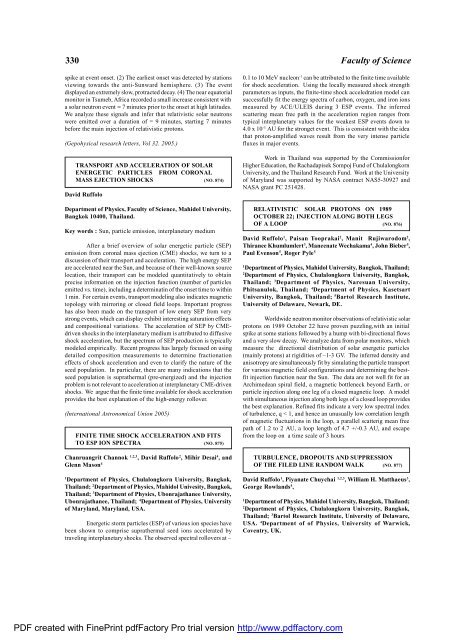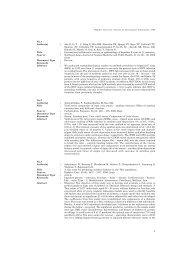Faculty of Science - Mahidol University
Faculty of Science - Mahidol University
Faculty of Science - Mahidol University
Create successful ePaper yourself
Turn your PDF publications into a flip-book with our unique Google optimized e-Paper software.
330<br />
spike at event onset. (2) The earliest onset was detected by stations<br />
viewing towards the anti-Sunward hemisphere. (3) The event<br />
displayed an extremely slow, protracted decay. (4) The near equatorial<br />
monitor in Tsumeb, Africa recorded a small increase consistent with<br />
a solar neutron event = 7 minutes prior to the onset at high latitudes.<br />
We analyze these signals and infer that relativistic solar neutrons<br />
were emitted over a duration <strong>of</strong> = 9 minutes, starting 7 minutes<br />
before the main injection <strong>of</strong> relativistic protons.<br />
(Gepohysical research letters, Vol 32. 2005.)<br />
TRANSPORT AND ACCELERATION OF SOLAR<br />
ENERGETIC PARTICLES FROM CORONAL<br />
MASS EJECTION SHOCKS (NO. 874)<br />
David Ruffolo<br />
Department <strong>of</strong> Physics, <strong>Faculty</strong> <strong>of</strong> <strong>Science</strong>, <strong>Mahidol</strong> <strong>University</strong>,<br />
Bangkok 10400, Thailand.<br />
Key words : Sun, particle emission, interplanetary medium<br />
After a brief overview <strong>of</strong> solar energetic particle (SEP)<br />
emission from coronal mass ejection (CME) shocks, we turn to a<br />
discussion <strong>of</strong> their transport and acceleration. The high energy SEP<br />
are accelerated near the Sun, and because <strong>of</strong> their well-known source<br />
location, their transport can be modeled quantitatively to obtain<br />
precise information on the injection function (number <strong>of</strong> particles<br />
emitted vs. time), including a determinatin <strong>of</strong> the onset time to within<br />
1 min. For certain events, transport modeling also indicates magnetic<br />
topology with mirroring or closed field loops. Important progress<br />
has also been made on the transport <strong>of</strong> low enery SEP from very<br />
strong events, which can display exhibit interesting saturation effects<br />
and compositional variations. The acceleration <strong>of</strong> SEP by CMEdriven<br />
shocks in the interplanetary medium is attributed to diffusive<br />
shock acceleration, but the spectrum <strong>of</strong> SEP production is typically<br />
modeled empirically. Recent progress has largely focused on using<br />
detailed composition measurements to determine fractionation<br />
effects <strong>of</strong> shock acceleration and even to clarify the nature <strong>of</strong> the<br />
seed population. In particular, there are many indications that the<br />
seed population is suprathermal (pre-energized) and the injection<br />
problem is not relevant to acceleration at interplanetary CME-driven<br />
shocks. We argue that the finite time available for shock acceleration<br />
provides the best explanation <strong>of</strong> the high-energy rollover.<br />
(International Astronomical Union 2005)<br />
FINITE TIME SHOCK ACCELERATION AND FITS<br />
TO ESP ION SPECTRA (NO. 875)<br />
Chanruangrit Channok 1,2,3 , David Ruffolo 2 , Mihir Desai 4 , and<br />
Glenn Mason 4<br />
1 Department <strong>of</strong> Physics, Chulalongkorn <strong>University</strong>, Bangkok,<br />
Thailand; 2 Department <strong>of</strong> Physics, <strong>Mahidol</strong> Univesity, Bangkok,<br />
Thailand; 3 Department <strong>of</strong> Physics, Ubonrajathanee <strong>University</strong>,<br />
Ubonrajathanee, Thailand; 4 Department <strong>of</strong> Physics, <strong>University</strong><br />
<strong>of</strong> Maryland, Maryland, USA.<br />
Energetic storm particles (ESP) <strong>of</strong> various ion species have<br />
been shown to comprise suprathermal seed ions accelerated by<br />
traveling interplanetary shocks. The observed spectral rollovers at –<br />
<strong>Faculty</strong> <strong>of</strong> <strong>Science</strong><br />
0.1 to 10 MeV nucleon -1 can be attributed to the finite time available<br />
for shock acceleration. Using the locally measured shock strength<br />
parameters as inputs, the finite-time shock acceledration model can<br />
successfully fit the energy spectra <strong>of</strong> carbon, oxygen, and iron ions<br />
measured by ACE/ULEIS during 3 ESP events. The inferred<br />
scattering mean free path in the acceleration region ranges from<br />
typical interplanetary values for the weakest ESP events down to<br />
4.0 x 10 -3 AU for the stronget event. This is consistent with the idea<br />
that proton-amplified waves result from the very intense particle<br />
fluxes in major events.<br />
Work in Thailand was supported by the Commissionfor<br />
Higher Education, the Rachadapisek Sompoj Fund <strong>of</strong> Chulalongkorn<br />
<strong>University</strong>, and the Thailand Research Fund. Work at the <strong>University</strong><br />
<strong>of</strong> Maryland was supported by NASA contract NAS5-30927 and<br />
NASA grant PC 251428.<br />
RELATIVISTIC SOLAR PROTONS ON 1989<br />
OCTOBER 22; INJECTION ALONG BOTH LEGS<br />
OF A LOOP (NO. 876)<br />
David Ruffolo 1 , Paisan Tooprakai 2 , Manit Rujiwarodom 2 ,<br />
Thiranee Khumlumlert 3 , Maneenate Wechakama 4 , John Bieber 5 ,<br />
Paul Evenson 5 , Roger Pyle 5<br />
1 Department <strong>of</strong> Physics, <strong>Mahidol</strong> <strong>University</strong>, Bangkok, Thailand;<br />
2 Department <strong>of</strong> Physics, Chulalongkorn <strong>University</strong>, Bangkok,<br />
Thailand; 3 Department <strong>of</strong> Physics, Naresuan <strong>University</strong>,<br />
Phitsanulok, Thailand; 4 Department <strong>of</strong> Physics, Kasetsart<br />
<strong>University</strong>, Bangkok, Thailand; 5 Bartol Research Institute,<br />
<strong>University</strong> <strong>of</strong> Delaware, Newark, DE.<br />
Worldwide neutron monitor observations <strong>of</strong> relativistic solar<br />
protons on 1989 October 22 have proven puzzling,with an initial<br />
spike at some stations followed by a hump with bi-directional flows<br />
and a very slow decay. We analyze data from polar monitors, which<br />
measure the directional distribution <strong>of</strong> solar energetic particles<br />
(mainly protons) at rigidities <strong>of</strong> –1-3 GV. The inferred density and<br />
anisotropy are simultaneously fit by simulating the particle transport<br />
for various magnetic field configurations and determining the bestfit<br />
injection function near the Sun. The data are not well fit for an<br />
Archimedean spiral field, a magnetic bottleneck beyond Earth, or<br />
particle injection along one leg <strong>of</strong> a closed magnetic loop. A model<br />
with simultaneous injection along both legs <strong>of</strong> a closed loop provides<br />
the best explanation. Refined fits indicate a very low spectral index<br />
<strong>of</strong> turbulence, q < 1, and hence an unusually low correlation length<br />
<strong>of</strong> magnetic fluctuations in the loop, a parallel scatterig mean free<br />
path <strong>of</strong> 1.2 to 2 AU, a loop length <strong>of</strong> 4.7 +/-0.3 AU, and escape<br />
from the loop on a time scale <strong>of</strong> 3 hours<br />
TURBULENCE, DROPOUTS AND SUPPRESSION<br />
OF THE FILED LINE RANDOM WALK (NO. 877)<br />
David Ruffolo 1 , Piyanate Chuychai 1,2,3 , William H. Matthaeus 3 ,<br />
George Rowlands 4 ,<br />
1 Department <strong>of</strong> Physics, <strong>Mahidol</strong> <strong>University</strong>, Bangkok, Thailand;<br />
2 Department <strong>of</strong> Physics, Chulalongkorn <strong>University</strong>, Bangkok,<br />
Thailand; 3 Bartol Research Institute, <strong>University</strong> <strong>of</strong> Delaware,<br />
USA. 4 Department <strong>of</strong> <strong>of</strong> Physics, <strong>University</strong> <strong>of</strong> Warwick,<br />
Coventry, UK.<br />
PDF created with FinePrint pdfFactory Pro trial version http://www.pdffactory.com
















